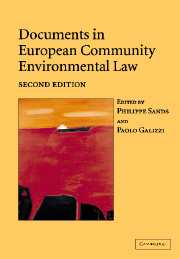Book contents
- Frontmatter
- Contents
- Preface
- PART I General principles of EC environmental law
- PART II European Community institutions and legislation
- PART III The relationship between environmental protection, financial assistance and free trade
- PART IV Procedural techniques of environmental protection
- PART V Protection of air quality
- PART VI Biodiversity and nature conservation
- PART VII Waste
- 33 Council Directive 75/442/EEC of 15 July 1975 on waste (OJ L 194 25.07.1975 p. 39)
- 34 Council Directive 91/689/EEC of 12 December 1991 on hazardous waste (OJ L 377 31.12.1991 p. 20)
- 35 Council Regulation (EEC) No 259/93 of 1 February 1993 on the supervision and control of shipments of waste within, into and out of the European Community (OJ L 030 06.02.1993 p. 1)
- 36 Council Directive 1999/31/EC of 26 April 1999 on the landfill of waste (OJ L 182 16.07.1999 p. 1)
- 37 Directive 2000/53/EC of the European Parliament and of the Council of 18 September 2000 on end-of-life vehicles (OJ L 269 21.10.2000 p. 34)
- 38 Directive 2000/76/EC of the European Parliament and of the Council of 4 December 2000 on the incineration of waste (OJ L 332 28.12.2000 p. 91)
- PART VIII Dangerous substances
- PART IX Water quality
33 - Council Directive 75/442/EEC of 15 July 1975 on waste (OJ L 194 25.07.1975 p. 39)
from PART VII - Waste
Published online by Cambridge University Press: 06 January 2010
- Frontmatter
- Contents
- Preface
- PART I General principles of EC environmental law
- PART II European Community institutions and legislation
- PART III The relationship between environmental protection, financial assistance and free trade
- PART IV Procedural techniques of environmental protection
- PART V Protection of air quality
- PART VI Biodiversity and nature conservation
- PART VII Waste
- 33 Council Directive 75/442/EEC of 15 July 1975 on waste (OJ L 194 25.07.1975 p. 39)
- 34 Council Directive 91/689/EEC of 12 December 1991 on hazardous waste (OJ L 377 31.12.1991 p. 20)
- 35 Council Regulation (EEC) No 259/93 of 1 February 1993 on the supervision and control of shipments of waste within, into and out of the European Community (OJ L 030 06.02.1993 p. 1)
- 36 Council Directive 1999/31/EC of 26 April 1999 on the landfill of waste (OJ L 182 16.07.1999 p. 1)
- 37 Directive 2000/53/EC of the European Parliament and of the Council of 18 September 2000 on end-of-life vehicles (OJ L 269 21.10.2000 p. 34)
- 38 Directive 2000/76/EC of the European Parliament and of the Council of 4 December 2000 on the incineration of waste (OJ L 332 28.12.2000 p. 91)
- PART VIII Dangerous substances
- PART IX Water quality
Summary
Editorial note
Council Directive 75/442 on wastes, as amended, requires Member States to take measures to prevent or reduce waste production and to recover waste by recycling, re-use, reclamation or any other processes, or to use waste as a source of energy (Article 3). Prevention and reduction are to be achieved by the development of clean technologies, products designed to minimise waste and techniques for the final disposal of dangerous substances (Article 3). Waste is defined as ‘any substance or object in the categories set out in Annex I which the holder discards or intends or is required to discard’ (Article 1(a)). The Directive does not apply to atmospheric emissions of gases or certain categories of waste covered by other legislation (Article 2(1)).
Member States should take measures necessary to ensure the recovery or disposal of waste without endangering human health and causing harm to the environment, including the prohibition of abandonment, dumping and uncontrolled disposal (Article 4). Member States are required to establish an integrated and adequate network of disposal installations, taking into account the best available technology not involving excessive cost (BATNEEC), designed to enable the Community to become selfsufficient in waste disposal (Article 5(1)). The network must enable waste to be disposed of in one of the nearest appropriate installations and ensure a high level of protection of the environment and human health (Article 5(2)). National authorities must drawup waste management plans and prevent movements of waste not in accordance with those plans (Article 7).
- Type
- Chapter
- Information
- Documents in European Community Environmental Law , pp. 617 - 626Publisher: Cambridge University PressPrint publication year: 2006
- 1
- Cited by



